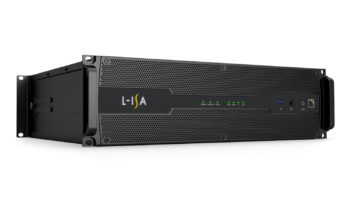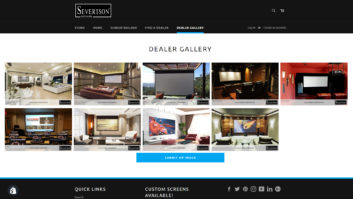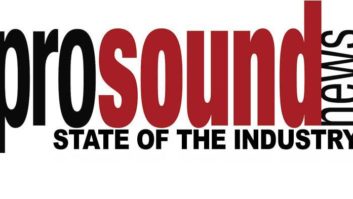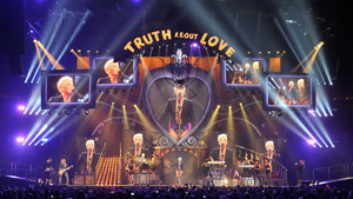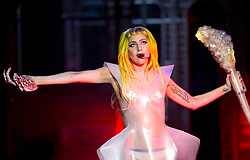
All photos: Steve Jennings
Lady Gaga is an experience. The performer. The artist. The musician. The fashion icon. The brand. And when “Mama Monster” hits the stage, all her little monsters in the Oakland Arena (Oakland, Calif.) eagerly pumped their paws to the sky in time with her chart-topping hits such as “Telephone,” “Paparazzi” and “Poker Face.” In part evoking a dance club atmosphere while quieting down for softer moments where she tickles the ivories for “You and I,” the Lady Gaga Monster tour is part visual spectacle—replete with numerous costume changes, each more interesting than the previous—and part true musicianship of Gaga and her 12-piece band.
But for front-of-house engineer Horace Ward, he humbly says that his role in the concert’s production is more “invisible.” “A concert is a feel,” he explains. “When you go to a club, you feel the music. It’s the same thing here. There are visuals that take your eye, but you still feel the music. It’s supposed to be that enhancement. It brings you closer to the stage, closer to the artist. The better the sound, the closer the artist seems to you. If you go away and say that guitar kind of hurt, you’re distracted by the sound; there should be no distractions like that. When you look at the P.A. and wonder what’s going on up there, then you’re taking your eyes away from the stage. I’ve got to be as loud as I can because it’s that club-type feel—big low end—but your eyes are supposed to be wandering around the stage. When you look at an instrument, you’re supposed to hear it. That visual thing is what it’s all about.”

Full Lady Gaga audio crew, from left: audio crew chief/monitor tech Dan Klocker, monitor engineer Ramon Morales, P.A. tech Wayne Bacon, FOH engineer Horace Ward, RF tech Bill Flugan, P.A. tech Kevin Szafraniec, FOH tech/system engineer Tony Smith, and P.A. techs James La Marca and James Allen
While Ward may be taking a backseat role in the concert’s experience, it’s his deft mixing—coupled with that of monitor engineer Ramon Morales—that truly makes a Lady Gaga show exciting and great-sounding.
A PRE-OWNED RIG
Both Ward and Morales came onto the tour later on the run (the arena dates are an off-shoot of the previous theater gigs) and adopted their respective setups from the previous FOH and monitor crew. Ward is mixing on an Avid VENUE Profile, a board he consulted on with the company. (For more on that collaboration, see the sidebar, “VENUE Input.”) Prior to setting foot on the tour, Ward was emailing desk files with the previous engineer to adapt the setup to his way of mixing, though those changes were limited. “You can’t redo the console without redoing a lot of other things,” Ward explains. “All of my effects would have changed, and I would have had to sit down for two days and really go through it, but I don’t have that time” as he started on the second show of the tour.
Morales is mixing on a DiGiCo SD7, a first for him. He’s using the board’s 80 inputs, with band effects and audience mics (four 414s and two shotgun mics strategically placed around the lip of the main and B stages) taking up the majority of that number; he works with wireless tech Bill Flugan to ensure that all wireless signals are up and running. The band is on Sensaphonics in-ears, while Gaga wears JH Audio; all mixes are straightforward. However, when Gaga takes to an instrument, Morales brings that instrument up in her ears enough for her to hear it, but at the same time, “I have to make sure it does not overpower everything else in her mix,” he says. “Her voice is her main instrument, and I have to make sure that she can always hear herself, the instrument that she is playing and the rest of the band onstage with her.”
For effects, he’s going the onboard route, and using Waves MultiRack (taken MADI through the desk) on vocals. He also uses a TC Electronic System 6000 for Gaga’s vocals and drums. “We have Gaga’s mic inputs going through UA 2-610 preamps, just to warm it up a little,” Morales says.
Ward is also using all onboard plug-ins (Waves, McDSP, Sony Oxford); because the board is Pro Tools–based, he is able to mix the show in a similar fashion as to how they did tracks in the studio. Granted, Ward was not present during those recording dates, but he takes a similar approach to his live mix. “Nowadays, you have to plan the mix like you’re doing an album. For example, the vocal chain, where you’re using compressors and various dynamic compressors within the chain, EQ, et cetera. [With a digital console,] a lot of stuff that you couldn’t compress because you didn’t have enough compressors, you can now compress; it’s all about control. With live, you can’t overcompress stuff like you do in the studio, but you can control everything. You can control the dynamics to where you want it to be, but you do have to get to that studio technique so the quality shines through. I’m working with a sequencer that’s pumping, a full band that’s pumping, string instruments, violin and the harp [which is featured on “Telephone,” as it’s the lead instrument]. I’ve got to be able to let [the harp] shine through. Balancing the drums with the sequenced drums and everything else—it’s all about control.”

Monitor engineer Ramon Morales mans the DiGiCo SD7
AMPLIFYING A AND B STAGES
The Eighth Day Sound–supplied d&b P.A. comprises four flown J8 sidefills (“light, but efficient,” Ward says), and on the B stage are four M4 wedges. Both the sidefills and wedges run digitally through Dolby Lake processing. When the dancers perform on the B stage, that’s where the M4 wedges really kick in, says Morales.
The 12-piece band—which includes background vocals, guitarists, harpist, bassist, drums, etc.—sees a plethora of mic options. Drums take Audio-Technica AE2500 on kick, AT 5100 on bottom snare, and AT 3000s on top snare and the three toms, as well as Neumann KM184s on hi-hat and ride. All other instruments are taken DI. For guitars, Ward places AT4050 on the amps and then adds DI. “I have to put a slight, maybe 0.4 millisecond, delay between the DI and the mic because they don’t match up time-wise,” Ward says. “Harp is DI’d. It’s got contact pickups on every string that sums.”
Gaga uses a Shure Beta 54 headset and switches to a Sennheiser SKM 5200 with 5235 capsule for a couple of songs. The three background vocalists use Sennheiser SKM 5200 with 5235 capsules for the entire show.
“I’m not fond of the Shure headset myself,” Ward says. “It was one of the things I have to work with and I’ve tried other mics. It’s got this midrange in it that really kills me, but I’ve learned to work with it. But everybody loves the sound of it. It’s one of the better-fitting mics, that’s the thing. Proportion-wise, it’s a fantastic mic. It fits real well, the capsules are unobtrusive. This is a small capsule and it’s just a good size, but the midrange on it just wears me out; it’s so excessive. I’m using the C4 to hit that midrange when she talks. You set the bandwidth by ducking it and EQ in the chain. It’s more the C4 dynamically that’s controlling how much of the midrange and low end come out.”
And it is that low profile that really helps both Ward and Morales during their mix as there are some costume headpieces that cover her entire face. Despite how close the cloth is to Gaga’s mic, Ward is able to send out a clean sound and Morales doesn’t have to change the mix going to her in-ears. Morales adds that there is a Shure Beta 54 for one of the dancers who speaks during one of the songs.
“You have to translate each song to what’s happening onstage,” Ward says. “The dynamics in her vocal when she plays the piano is she can go to a whisper to talking to singing out. So that vocal when she’s talking quietly, you’ve got to enhance that to come over the music and be clear. It changes all the time. It’s more dramatic than a song that’s pumping all the way through because it’s from one end of the scale with quiet piano, voice—not screaming but talking so everybody can hear her—to a voice where there’s a full band, so you enhance [the instruments] so they cut through and the vocal has to cut through, as well.”

Front-of-house engineer Horace Ward at the Avid VENUE Profile
VENUE INPUT
When Avid was designing its VENUE Profile live sound console, they asked Ward to visit and give his thoughts on the design. Here’s his tale:
“The company said, ‘We’re bringing out a new console, can you look it over?’ And I looked at it, and said, ‘This is too big,’ and, ‘What’s this?’ My thing were the gates and compressors they had on it—I didn’t like it. But they started using their same workings as their plug-in gates and compressors, so that was beautiful. Also, the knobs on the console, they used the same ones they use on their studio consoles—the D-Control. I tried to change the knobs, but they kept the D-Control-type knobs. This was the original VENUE.
“Different things like we wanted the playback from Pro Tools. When the console first came out, it didn’t have it, but it was one of those things they planned to do and it was cool. The Rehearse mode: It’s one of those things where it’s a tool you can use after the band’s finished and go back and refine your mix. It’s always good to go back and sort out an effect. Same thing you do in the studio: You’ll stay in the mix and sort out what suits the mix. Before, we were limited in what we had and you just had certain things you knew worked; certain reverbs you’d use for vocal, for drums, maybe an instrument one and that’s all you’d do. But now, because the way the board’s set up and how many sends you have, you can add atmosphere to individual things. And you can change all that per song; you can’t change the actual unit, but you can change textures and the times per snapshot.”
Sarah Benzuly is
Mix
’s managing editor.
